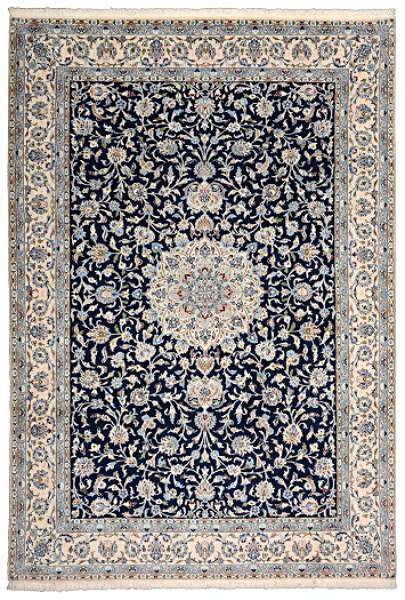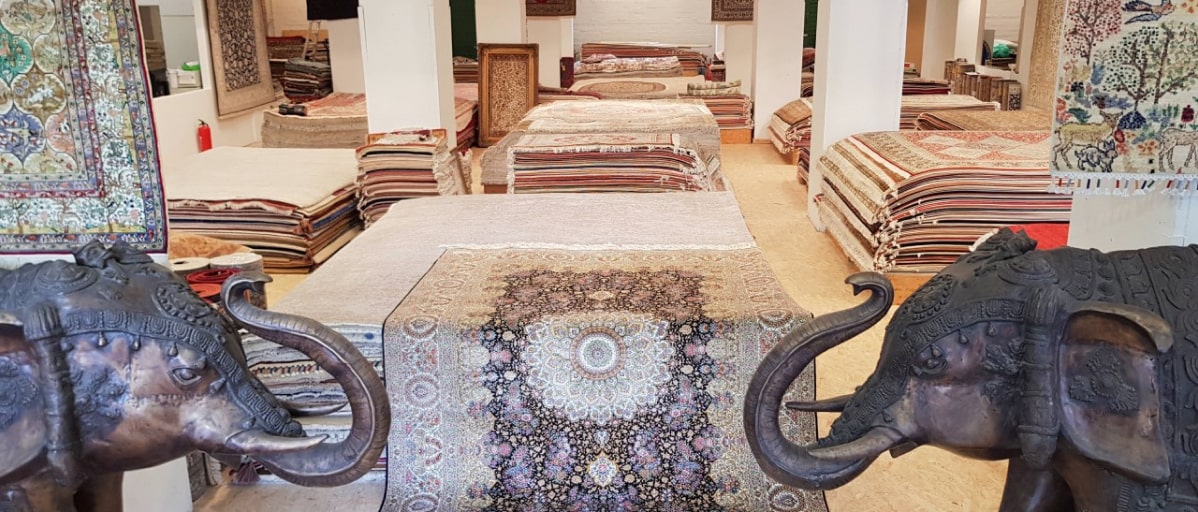Persian Rugs

Persian rugs overview
- Traditional Persian rugs - types and variety at a glance
- Patterns and colors of Persian rugs
- Characteristics of a traditional Persian rug
- Care and Cleaning of Persian Rugs
- Buy a traditional Persian rug at Rugway
Traditional Persian rugs - types and variety at a glance
Next to Turkish and Afghan rugs, Persian rugs are the most well-known hand-knotted oriental rugs. Persian rugs are commonly referred to as rugs from modern-day Iran that are designed in floral patterns and vibrant colors. The nomadic rugs hand-knotted in Iran are not strictly speaking counted among the classic Persian rugs, as they are usually knotted in darker colors and geometric patterns.
The term Persian rug as such has been retained for the rugs, even though politically the designation of the country as Iran has been established for several decades. A Persian rug is characterized - as already mentioned - by its floral patterns. The great variety of Persian rugs is named after the provenances, cities and villages
History of Persian rugs
Iran is a multi-ethnic country and combines many cultures together. The region of Azerbaijan is considered one of the cradles of the Iranian rug industry. Documents prove that Persian rugs and kilims are at least 1200 years old. Under the Seljuks, the craft of knotting became popular in Persia. The heyday of traditional Persian rugs was in the era of the Safavids, who particularly promoted this art form. Until the 15th century, almost exclusively geometric motifs were used. After that, plants and sweeping arabesques increasingly appeared. They were inspired by the then widespread art form of miniature painting. Since then, the artistic rug design has been clearly separated from the actual execution of the knotting work. Talented draftsmen made knotting patterns for Persian rugs on cardboard or paper, which became the binding template. The Persian rugs known to us today mostly date from the Shah period. Under the Persian Shah, the Persian rug gained great importance as an export commodity and is today inextricably linked with Persian tradition.
The most famous Persian rug provenances
- Tabriz rugs - They have been knotted in the city on the former Silk Road since the 16th century.
- Nain rugs - Particularly bright and magnificent Persian rugs worked with silk.
- Sarough rugs - Large and ancient rugs also known as American Sarough.
- Bijar rugs - An extremely sturdy and strong rug that often lasts for decades.
- Isfahan rugs - The finest, most colorful and magnificent knotted works of art in the world.
- Keshan rugs - Large ornaments in red and blue colors, with a good price-quality ratio.
- Hamedan rugs - Hamedan rugs are Persian nomadic rugs from Hamedan province.
Most important distinguishing features of Persian rugs
In addition to the provenances listed above, there are countless other smaller towns and villages after which Persian rugs are named. Even many experts can hardly distinguish them. The biggest differences in the various provenances are:
- Knotting density
- Color
- Design
- Ornament
- Manufacture
On the other hand, they can be compared in their materials used and the symmetrical and asymmetrical so-called Persian knot. For example, the Isfahan and Gabbeh rugs are two Persian rugs that differ greatly in their appearance. The Isfahan is one of the finest and most colorful Persian rugs. A Gabbeh rug, on the other hand, is rather plain in appearance, as this type is a plain wool rug.
Hand-knotted Persian rugs - the Permium rug for the home
For rug lovers, there is always also a variety of unique pieces available, which fit the respective high demands. One thing is guaranteed: The purchase of a genuine Persian unique piece, whether for the living room or the bedroom, brings an exotic flair into your home. In addition, the world of Persian rugs offers a wide area in which you can quickly lose yourself as a layman. Small, barely apparent differences, can sometimes have great significance. To find a real expert in Persian rugs, who is also familiar with the smaller and older provenances, has become difficult today.
Patterns and colors of Persian rugs
Classic Persian rugs are knotted exclusively in floral and vase patterns and are usually decorated with a beautiful ornament or medallion in the center. Through-patterned, meaning with a repeating motif, Persian rugs are rarer. The frame around a Persian rug forms the so-called border. Similar to the frame of a painting, the border encloses the ornament of the rug and gives the rug its rectangular shape. In order to show off the magnificent effect of these patterns, the knot density is somewhat higher than in other oriental rugs. Natural and vegetable dyes are used to dye the virgin wool, as they have proven their durability and beauty over synthetic dyes. For example, the blue color of Persian rugs is obtained from indigo. Commonly used colors are for example red, beige and blue. But also colors like turquoise, brown, pink or yellow are often used for Persian rugs.
Vegetable dye as a long-term promise of quality
Rugs dyed with vegetable dyes often develop their true beauty only in the course of time, because the dyes become more uniform and harmonious with time. Old and antique Persian rugs are therefore particularly sought after among collectors and enthusiasts and can accordingly achieve a higher value than new Persian rugs. A Kirman rug, for example, was sold at a London auction in 2010 for an incredible seven million euros and has since been considered the most expensive Persian rug in the world. Shortly before, this rug was unknowingly listed at 900 euros.
Characteristics of a traditional Persian rug
To distinguish between an original Persian rug and a hand-knotted rug from, for example, India or Pakistan, is not easy for a layman because recognizing the most important distinguishing features requires a lot of experience. Indian rugs often look very perfect and adapted, while a Persian rug has a natural authority that gives you a feeling of uniqueness and value. Unfortunately, objective distinguishing features can usually only be recognized by experts. It is therefore advisable to seek the advice of an expert if you have questions about the origin. Our information about the origin of the rugs can be found on the detailed pages. Of course, we can also issue certificates of authenticity upon request.
Care and cleaning of Persian rugs
Persian rugs tend to be very easy to care for. Unless it is an extremely fine or expensive Persian rug, daily wear and weekly vacuuming will not harm it for decades. The natural vegetable dyes, the dense weave and the natural grease of the virgin wool provide protection so that most dirt does not penetrate the rug in the first place. Only the smallest sand and dust particles can settle in the foundation over time. To get the smallest dust particles out of the Persian rug, it is recommended to clean the rug every 3-5 years by professional rug washing.
Everyday dangers for genuine Persian rugs
In everyday life, Persian rugs know only two enemies: red wine and years of sun exposure. Red wine stains can be treated, but cleaning is extremely time-consuming and therefore a not insignificant cost issue. Against one-sided sun exposure, it often helps to turn the rug at even intervals so that both sides are exposed to a similar amount of sunlight. Sun does not necessarily cause a rug to depreciate in value. Many old and antique Persian rugs have only become particularly beautiful and valuable because of their even exposure to sunlight. Some Persian rugs are even placed in the sun for an extra long time to give the color a brighter and more balanced shine. If only water comes into contact with a Persian rug, it is usually sufficient to pat it vigorously dry from both sides. The rug will lift for a few days on the wet spot as moisture causes the warp to expand. Once the moisture has escaped the rug, the warp will settle again and the rug will be unchanged. Vigorous dry rubbing of water stains or the use of cleaning products should be avoided, as both can damage the Persian rug. In case of coffee or cola stains, you should contact a specialist as soon as possible. You can treat the stain yourself with lukewarm water and washing-up liquid. However, you should seek the advice of an expert before doing so.
Buy a classic Persian rug at Rugway
For our selection of classic Persian rugs, we always pay attention to outstanding knotting and wool quality. It is a basic requirement for colors and patterns to last for a long time and give you a lot of pleasure. We offer you a comprehensive cross-section of the world of Persian rugs: From Nain to Loribaft you can order everything online. However, if you have not found your dream rug or have further questions about rugs from Iran, please do not hesitate to contact us. We will be happy to send you suggestions that meet your expectations. If you would like to buy a Persian rug, we offer a 30-day return policy and free round-trip shipping. Our certification with the well-known TrustedShops seal of approval also speaks for our quality and customer-friendliness standards. In addition, you can view the reviews of other customers.








































